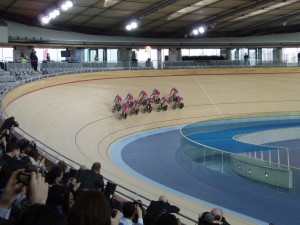
I attended the opening ceremony for the velodrome today. The velodrome is a venue we are particularly pleased with as a commission as it is a real sustainability success story.
One of my roles in the Commission is to track all the commitments that the delivery bodies have made to ensure they are progressing against them. This has meant I have been able to see how all the venues have developed throughout their design and build. The velodrome has consistently stood out as its innovative design has helped it meet or exceed all the targets set for it.
For example, the ODA required all the venues to be at least 15 percent more energy efficient than standard venues. The velodrome is over 30 percent more efficient, doubling the target set. Its rainwater harvesting system means it also nearly doubles the 40 per cent target for reduction in potable water use. I was also pleased to see the sustainably sourced timber track that Sir Chris Hoy, Victoria Pendleton and other members of Team GB were cycling round today.
The velodrome is also a great example of carbon efficient design. Using a lightweight structure with a timber clad cable net roof, the steel required for the roof is only 100 tonnes. This gives it a much lower carbon footprint than a traditional venue.
I believe the velodrome also shows that you can have a stunning design and a highly sustainable venue. Something another similar sized building to the south of it could learn from?
I hope that as we come to the Games and hopefully see many British gold medals won at the velodrome, we can also celebrate and replicate the great sustainability lessons from this amazing venue.
Jonathan Turner
22 February 2011

Unfortunately what CSL continually fail to pick up on in their audits is the culture of learning and change. It is this process that drives a sustainable Legacy, not a single Venue.
If you want to understand the difference just compare the development and learning around sustainability between the two Venues design teams and contractors.
Hopkins and Expedition, have clearly shown that they ‘get’ sustainability and did 5 years ago when the Velodrome design process started. Meanwhile, 7 years ago, when the Aquatics concept came into fruition Zaha Hadid architects were all about awe-inspiring architecture – and they certainly haven’t failed us there.
But in the process of working on the Olympics, Zaha Hadid’s architects have pioneered sustainable concrete design and use, found innovative solutions to tackle issues associated with limited supplies of FSC certified timber…and more.
Meanwhile the Aquatics contractors, Balfour Beatty, also had to up their game to deliver against the challenging sustainability targets, presented with a design that was not initally borne out of sustainability.
Balfour Beatty have turned their procurement processes upside down to excel in sustainable construction. Engaging early with their supply chain to innovate, integrating sustainability into every step of procurement and sub-contract award, recognising the value of rail transportation for material deliveries, I could go on.
Perhaps most importantly, the UK’s largest construction firm has developed a visionary corporate strategy that utilises the success of the Aquatics Centre to engage and inspire their whole organisation. The potential impact is far more significant and further reaching than a single Venue.
By all means CSL, highlight the shortfalls. We must recognise our failings to improve. But please, be a bit more insightful about what the Olympics is about. The Aquatics Centre as the bogey man on the Park is tiring, and not at all reflective of the transformational change it has driven across the construction sector. Nor does it credit those that have worked tirelessly over the last 6 years to engage every level of the organisations involved to deliver lasting change.
Kirsten’s comments have highlighted some important lessons arising from the design and construction process for the London 2012 programme. We wholeheartedly agree that this important learning legacy needs to be captured and available for the wider industry. Indeed, section 13 of our 2010 Annual Review, entitled ‘Making a Difference’, covers off the benefits of the legacy of learning from the programme and acknowledges the ODA’s considerable efforts in this area.
With respect to the Aquatic Centre, in Paragraph 9.13 of our 2010 Annual Review we have recognised the excellent effort of the Aquatic Centre teams to improve the environmental impact of the building.